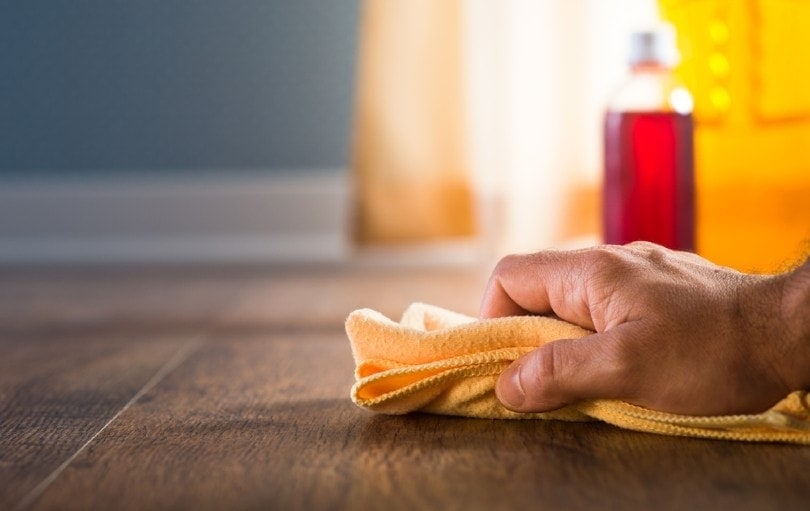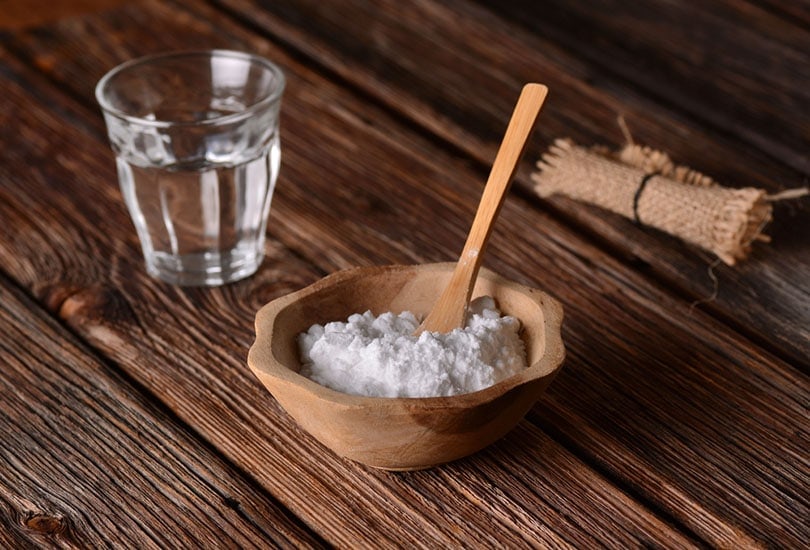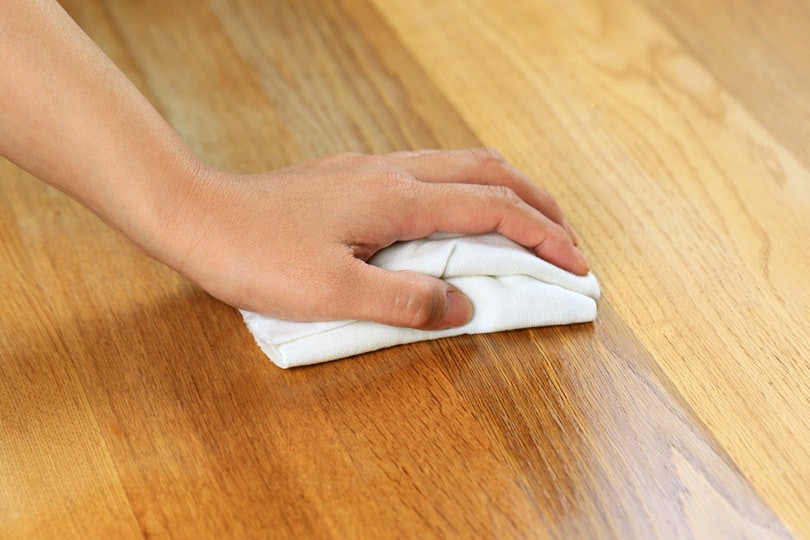How to Get Dog Pee Smell Out of Laminate Flooring: 6 Practical Options
-
Pete Ortiz
- Last updated:

Stain resistance is an essential selling point of laminate flooring, but that doesn’t mean it’s immune to tough stains. When it gets a chance to sit, a liquid spill can turn into a time-consuming cleaning chore, especially if it’s a particularly acrid substance like dog urine. Sometimes, all it takes is one serious accident for your laminate floor to take on a seemingly permanent dog pee smell.
When you have tried cleaning, and the smell keeps returning, revitalizing your floor to a like-new, stink-free state can feel like a hopeless endeavor. If you’re still stuck battling the stench, we will run through six practical options to get dog urine out of laminate flooring that you can try today.
The 6 Best Ways to Get Dog Pee Smell Out of Laminate Flooring
1. Enzyme Cleaner

- Enzyme cleaner
- Mop or scrubbing sponge
- Broom
An enzyme cleaner is the most effective cleaner on dried dog pee. When the urine smell sets in, you can use a spray solution to remove the odor-causing particles.
Uric acid crystals penetrate deep into flooring, and traditional cleaning approaches often can’t dissolve and wash them away. An enzyme cleaner breaks down the dried urine components that create the odor so they can evaporate harmlessly into the air.
First, remove any dirt and grime from the floor so the enzyme cleaner can penetrate the laminate surface. Spray the cleaner and scrub it in with a sponge or soft-bristled brush. Avoid using abrasive material like steel wool, which can scratch the finish.
Are you looking for an enzyme cleaner that can keep your house clean and your pet happy? We recommend the Hepper Advanced Bio-Enzyme Pet Stain & Odor Eliminator Spray, which permanently gets rid of the most stubborn stains and smells. There’s even a 100% satisfaction guarantee so you can try this cleaner risk-free! Click here to order your first bottle.
At House Grail, we’ve admired Hepper for many years, and decided to take a controlling ownership interest so that we could benefit from the outstanding products of this cool cat company!
2. Baking Soda

- Baking soda
- Water
- Vacuum
- Sponge or soft-bristled brush
As a versatile DIY cleaner, baking soda can remove the dog pee odor from your laminate flooring if you don’t have an enzyme cleaner available. Baking soda’s absorbency will eliminate the lingering liquid, and its alkalinity aids in neutralizing odors. Clean any dirt and moisture from the area with a vacuum or paper towel. Then, you can try two approaches to clean the urine with baking soda.
The first option is to sprinkle baking soda over the stain. Let it sit for a few hours to absorb odors and moisture before vacuuming it up. Another approach is to mix baking soda with warm water to form a paste. Work the paste into the stain with a sponge or soft brush. Let it sit for 2–3 hours before wiping it up.
3. Vinegar and Water

- Distilled white vinegar
- Water
- Spray bottle
- Clean cloths or sponges
- Broom
Vinegar can be a helpful, fizzy follow-up to baking soda; it provides an added boost to remove deep-down dirt. After applying baking soda, you can spritz it with vinegar to create a bubbling reaction that lifts dirt to the surface. And if you don’t have baking soda, you can try attacking the stain with vinegar.
First, blot up any remaining liquid from the floor before cleaning. Mix a solution of vinegar and water in a 1:1 ratio in a spray bottle, and saturate the stained area. Work it in with a clean cloth or sponge. Dry the floor thoroughly with a cloth or paper towel, and the vinegar smell will dissipate as any lingering cleaner evaporates.
4. Hydrogen Peroxide and Dish Liquid

- 3% hydrogen peroxide
- Mild dish liquid (e.g. Dawn liquid soap)
- Spray bottle
- Baking soda (optional)
- Clean cloths
- Broom
If you can’t find the solution in the pantry, you might find it in the medicine cabinet. Hydrogen peroxide is a safe cleaner for laminate flooring, working in a pinch if you’re all out of vinegar and baking soda.
Before using the hydrogen peroxide, sweep away the dirt or grime from the stained area. Mix ¼ cup or more of 3% hydrogen peroxide with a few drops of liquid dish soap in a spray bottle. Spritz the stain and let the cleaner sit for 10–15 minutes.
If you have baking soda, sprinkle it on the saturated area, allowing it to absorb any remaining liquid and odors. Dab the baking soda into the flooring to penetrate crevices where moisture might hide. Let it dry for 1–2 hours before vacuuming.
5. Rubbing Alcohol

- Isopropyl alcohol
- Clean cloths or paper towels
Another household ingredient to try on fresh dog pee is isopropyl (rubbing) alcohol. you can use it to disinfect and efficiently lift urine residue from laminate flooring.
Blot up any remaining urine until the floor is as dry as possible. Dampen a cloth with rubbing alcohol and dab the stain until it is clean. Dry any remaining alcohol from the floor.
Note: If you have distilled white vinegar, you can make a cleaning mixture of water, vinegar, and alcohol in equal amounts with a few drops of dish liquid added. Spray the solution on your floor and mop up the stain. Blot up any remaining liquid and let the area dry.
6. Replace the Flooring

- Utility knife
- Claw hammer
- Tape
- Replacement flooring
- Flooring adhesive
Although hard flooring is generally water-resistant, gaps between boards allow moisture to penetrate underlayment and subfloors. As with carpet, that creates deep-set odors that most solutions can’t reach from the surface. In these instances, you must remove the stained flooring and clean it underneath.
Fortunately, an essential benefit of laminate flooring is how easy it is to replace one section at a time. If the stain is near a wall, you can remove the baseboard and flooring planks until you reach the stained section. Swap out the soiled pieces and put the other planks back in place.
When the stain is in the middle of the floor, use a utility knife to cut the plank out. Apply adhesive along the tongue and groove of the new plank to adhere it to the surrounding floor.
Tips for Effective Odor Removal
While these six techniques for cleaning dog pee can be effective in various situations, there are a few tips to keep in mind to save time and effort when your pup has an accident.
Don’t Try Bleach
Bleach and other toxic chemicals are excellent disinfectants, but the source of the odor has little to do with active microorganisms. Instead, uric acid crystals that bind tightly to flooring release odors as they become moist from humidity or liquid contact. A cleaner like bleach may mask the scent temporarily due to its strong aroma, but it won’t remove any odor-causing particles.
Clean the Pee Immediately
The best way to handle potent pee smells is to prevent them from occurring in the first place. Whenever your dog has an accident, it is crucial to dry up as much as you can to keep it from sinking deeper into the floor. Even if you can’t apply a cleaning spray immediately, do what you can to mop up the mess and come back to clean it later.

Use a UV Light to Seek Out Urine Stains
When dealing with an old dog urine odor, it can be a challenge to find the source just by sniffing it out. If you can’t pinpoint the smell, use a UV pet urine flashlight to locate the stain.
Under UV light, dried dog pee shines a yellowish-green, helping you find every last hidden stain. Once you locate them, cleaning all the stains with an enzyme cleaner will not only remove the smell but also help you prevent future accidents in the same spots.
 Conclusion
Conclusion
Dog urine may be particularly nasty and arduous to remove, yet the surest cleaning solutions are often the most gentle. An enzyme cleaner is the most effective method to remove the smell and any trace of dog urine. However, if you don’t have time to run to the store, you can use the household ingredients we discussed to remove the odor and stain from your laminate flooring for good.
Related Read: How To Clean Pet Urine from Vinyl Plank Flooring: 4 Practical Steps
Featured Image Credit: Twinkle Studio, Shutterstock
Contents



